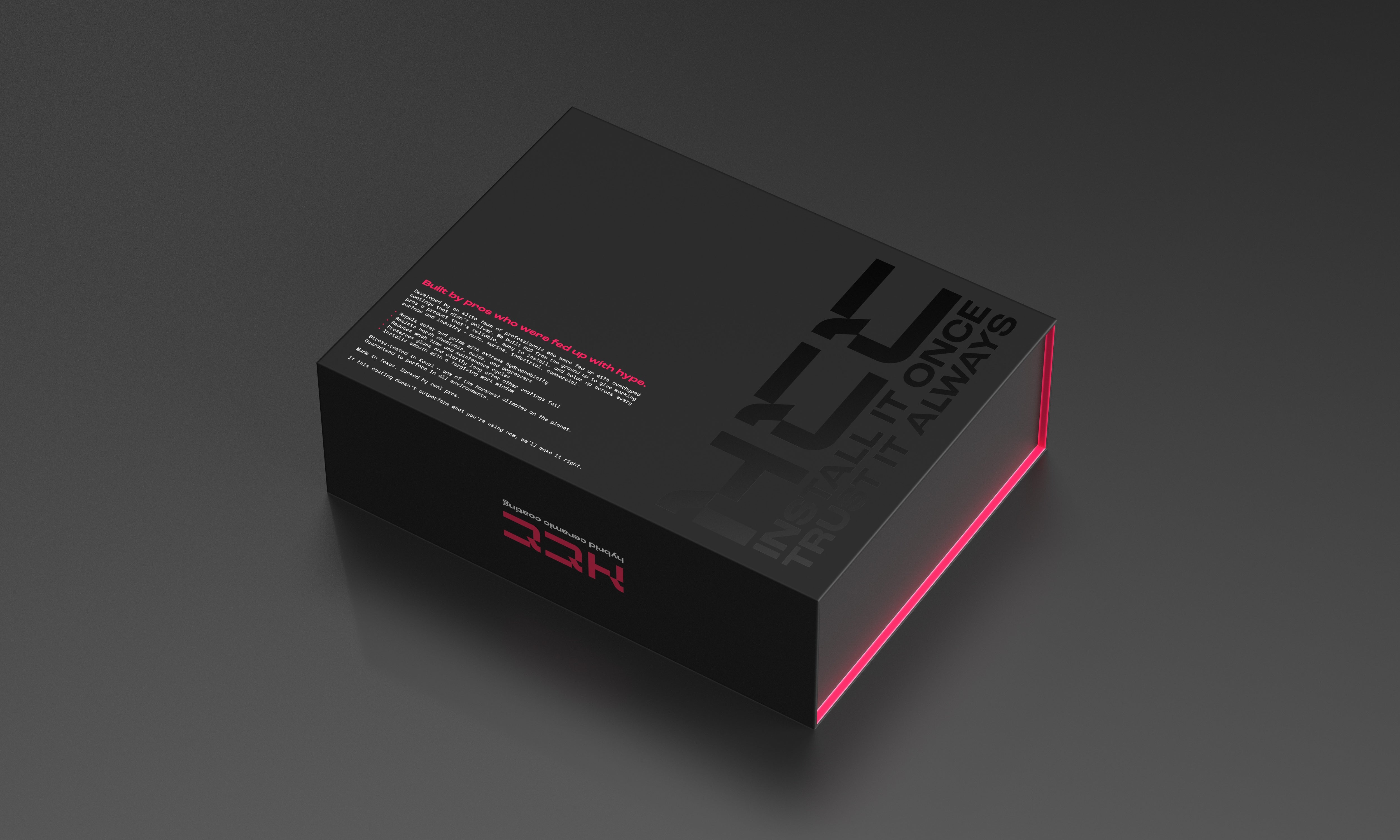HCC – Hybrid Ceramic Coating
Built to Outperform. Engineered for the Real World.
HCC isn’t just a “new coating”—it’s a complete redefinition of what professional-grade surface protection should look like. Designed from the molecular level up, HCC (Hybrid Ceramic Coating) is a high-solids, no-BS coating that sets a new benchmark for durability, chemical resistance, and real-world performance—period.
We didn’t build HCC to compete with what’s already out there. We built it to outperform it. Whether you’re looking at big-brand ceramics, silica-heavy glass coatings, or boutique blends with inflated claims—HCC simply lasts longer, protects better, and stays cleaner between washes than any coating in its class....
How do we know?
Because we’ve tested it.
Not in a lab under perfect conditions—but on real vehicles, in real climates, with real abuse. And in those conditions, HCC holds its gloss longer, resists chemicals better, and accumulates noticeably less dirt and bonded contamination between washes compared to every major coating we’ve tested it against. That means fewer decons, fewer wash-induced swirls, and a surface that truly stays slick, clean, and easy to maintain—even months or years down the road. All testing done in Hawaii, California Texas, Florida, Michigan and New York.
The Science Behind the Superiority
HCC uses a proprietary hybrid resin matrix that cures into a dense, crosslinked protective shell. This isn’t your typical silane, polysiloxane - or silica-based coating that relies on fragile crystallization and flashy filler. HCC crosslinks at the molecular level to form a highly stable, highly functional film that delivers:
-
High surface tension + tight bonding = less dirt accumulation
-
Extreme resistance to acids, alkalis, and solvents
-
Flexible durability that moves with the surface—never flakes or cracks
-
Zero gimmicks: no fake gloss boosters, thickening agents, or filler resins. HCC has actual solids you can see
Each component in the formula is selected for one reason: performance. Every drop is functional—nothing added for liquid volume enhancement, false slickness, or cosmetic gimmicks like graphene. That means you get maximum resin-to-surface transfer, higher film density, and stronger performance per install.
Application Behavior: Predictable, Tunable, Installer-Approved
HCC was engineered to give professional detailers more control over the install process, not less.
Its flash time is humidity-dependent—the more humid the environment, the faster the coating will flash. But instead of rushing the process, we encourage installers to explore the boundaries of the coating. In drier climates or controlled environments, allowing HCC to flash longer—up to or beyond—results in an even tighter film, smoother wipe, and superior end result. ** we advise not rushing the wipe off sooner than what the coating needs in your environment, as it could compromise this coatings performance and durability
And despite how much product you load onto the pad (yes, we know you’re saturating it), HCC won’t crystallize inside your applicator. Thanks to its highly volatile solvent base and surface-only curing behavior, the pad stays usable—even after extended sessions. Basically we designed this product to attract itself to the surfaces you apply it too and not the applicator pad like traditional coatings.
-
Flash Time: Dependent on humidity; more humid = faster flash
-
Ideal Wipe-Off Window: once residue disappears by wiping it in
-
Cure Time: Dust- and tack-free in ~4 hours, full chemical resistance in 5–7 days
-
No streaking, no rainbowing, no pad lock-up
Why HCC Outlasts Everything Else
You can market longevity all you want—but what makes HCC actually last longer?
-
Superior resin-to-solids ratio: More usable active material = thicker, stronger film
-
Crosslinked barrier network: Won’t shear or erode like glass-heavy coatings under abrasion
-
Exceptional hydrophobic + oleophobic behavior: Keeps water, grime, and oils off the surface longer
-
Better adhesion: Anchors into clear coat or gel coat without brittle bonding failures
-
Thermal and chemical resilience: Won’t soften or degrade under high-heat, acid rain, or strong soaps which is typically the killer of coatings
In short: it sticks better, resists more, cleans easier, and keeps going.
Is It Worth the Extra Cost?
Yes—and here’s exactly why.
We won’t sugarcoat it: HCC costs more than our other coatings, and you’ll use more of it per vehicle. It’s not hyper-concentrated marketing fluff. It’s a coating built for performance, not to stretch margins at the expense of protection.
But that extra cost? It delivers real, measurable value where it actually matters—in the field.
Here’s what that translates to:
-
Better film build = better protection. You’re laying down more active material per install, which means thicker, denser coverage and a coating that actually stands up to the environment—not one that starts failing after a year.
-
Longer lifespan. You’ll be seeing this coating bead, sheet, and hold gloss long after others start ghosting. That’s fewer re-installs, fewer touch-ups, and fewer pissed-off customers asking why their “3-year” coating died in 12 months.
-
Cleaner surface between washes. Less bonded contamination, less embedded dirt, easier decon, and happier maintenance clients. That saves time and product on wash and upkeep.
-
Extreme chemical resistance. Stronger defense against degreasers, salt, acidic fallout, and hard water—especially important for shops dealing with harsh climates or industrial vehicles.
-
Installer efficiency. Wide flash window, zero high spots, soft pads, no panic. You get clean installs, smooth wipes, and zero wasted motion.
So yeah—it may cost a bit more up front, and you’ll use more coating.
But what you get in return is:
More trust from your clients
Fewer warranty calls or failures
Longer-lasting results
Better installs
More pride in your work
If you’re charging premium prices for your services, HCC justifies every penny. It’s the coating you use when “good enough” isn’t even in the conversation.
Ideal For:
-
Detailers who want one flagship coating that does it all and outperforms and lasts them all
-
Installers who work in extreme or mixed climates
-
High-volume shops looking for fast flash, low failure rate, and high customer retention
-
Pros who are tired of coatings that fade in 12 months but still call themselves “5-year” products
Specs at a Glance:
-
Longevity: Designed to outperform any coating on the market
-
Cure Time: 4 hours dust-free; full cure in 5–7 days
-
Film Thickness: ~1–1.5 microns per layer, more when applied thick
-
pH Resistance: High
-
Thermal Tolerance: Up to 1,200°F on metal surfaces
-
VOC Compliant: Yes (U.S. & Canada)
-
Compatible Surfaces: Paint, gel coat, metal, glass, PPF, vinyl, plastic trim and much more
Final Word
HCC isn’t just tough—it’s tuned.
Every aspect of this coating was developed to give pros like you an edge: more installs per bottle, faster wipe-offs, no pad waste, and results that don’t wash away with time. Whether you’re working on a $500K exotic, a daily driver, or a full fleet—you want one coating you can trust, not a shelf full of hype.
HCC delivers.
Packaging you receive may not exactly match featured images.
HCC – Hybrid Ceramic Coating
Built to Outperform. Engineered for the Real World.
HCC isn’t just a “new coating”—it’s a complete redefinition of what professional-grade surface protection should look like. Designed from the molecular level up, HCC (Hybrid Ceramic Coating) is a high-solids, no-BS coating that sets a new benchmark for durability, chemical resistance, and real-world performance—period.
We didn’t build HCC to compete with what’s already out there. We built it to outperform it. Whether you’re looking at big-brand ceramics, silica-heavy glass coatings, or boutique blends with inflated claims—HCC simply lasts longer, protects better, and stays cleaner between washes than any coating in its class....
How do we know?
Because we’ve tested it.
Not in a lab under perfect conditions—but on real vehicles, in real climates, with real abuse. And in those conditions, HCC holds its gloss longer, resists chemicals better, and accumulates noticeably less dirt and bonded contamination between washes compared to every major coating we’ve tested it against. That means fewer decons, fewer wash-induced swirls, and a surface that truly stays slick, clean, and easy to maintain—even months or years down the road. All testing done in Hawaii, California Texas, Florida, Michigan and New York.
The Science Behind the Superiority
HCC uses a proprietary hybrid resin matrix that cures into a dense, crosslinked protective shell. This isn’t your typical silane, polysiloxane - or silica-based coating that relies on fragile crystallization and flashy filler. HCC crosslinks at the molecular level to form a highly stable, highly functional film that delivers:
-
High surface tension + tight bonding = less dirt accumulation
-
Extreme resistance to acids, alkalis, and solvents
-
Flexible durability that moves with the surface—never flakes or cracks
-
Zero gimmicks: no fake gloss boosters, thickening agents, or filler resins. HCC has actual solids you can see
Each component in the formula is selected for one reason: performance. Every drop is functional—nothing added for liquid volume enhancement, false slickness, or cosmetic gimmicks like graphene. That means you get maximum resin-to-surface transfer, higher film density, and stronger performance per install.
Application Behavior: Predictable, Tunable, Installer-Approved
HCC was engineered to give professional detailers more control over the install process, not less.
Its flash time is humidity-dependent—the more humid the environment, the faster the coating will flash. But instead of rushing the process, we encourage installers to explore the boundaries of the coating. In drier climates or controlled environments, allowing HCC to flash longer—up to or beyond—results in an even tighter film, smoother wipe, and superior end result. ** we advise not rushing the wipe off sooner than what the coating needs in your environment, as it could compromise this coatings performance and durability
And despite how much product you load onto the pad (yes, we know you’re saturating it), HCC won’t crystallize inside your applicator. Thanks to its highly volatile solvent base and surface-only curing behavior, the pad stays usable—even after extended sessions. Basically we designed this product to attract itself to the surfaces you apply it too and not the applicator pad like traditional coatings.
-
Flash Time: Dependent on humidity; more humid = faster flash
-
Ideal Wipe-Off Window: once residue disappears by wiping it in
-
Cure Time: Dust- and tack-free in ~4 hours, full chemical resistance in 5–7 days
-
No streaking, no rainbowing, no pad lock-up
Why HCC Outlasts Everything Else
You can market longevity all you want—but what makes HCC actually last longer?
-
Superior resin-to-solids ratio: More usable active material = thicker, stronger film
-
Crosslinked barrier network: Won’t shear or erode like glass-heavy coatings under abrasion
-
Exceptional hydrophobic + oleophobic behavior: Keeps water, grime, and oils off the surface longer
-
Better adhesion: Anchors into clear coat or gel coat without brittle bonding failures
-
Thermal and chemical resilience: Won’t soften or degrade under high-heat, acid rain, or strong soaps which is typically the killer of coatings
In short: it sticks better, resists more, cleans easier, and keeps going.
Is It Worth the Extra Cost?
Yes—and here’s exactly why.
We won’t sugarcoat it: HCC costs more than our other coatings, and you’ll use more of it per vehicle. It’s not hyper-concentrated marketing fluff. It’s a coating built for performance, not to stretch margins at the expense of protection.
But that extra cost? It delivers real, measurable value where it actually matters—in the field.
Here’s what that translates to:
-
Better film build = better protection. You’re laying down more active material per install, which means thicker, denser coverage and a coating that actually stands up to the environment—not one that starts failing after a year.
-
Longer lifespan. You’ll be seeing this coating bead, sheet, and hold gloss long after others start ghosting. That’s fewer re-installs, fewer touch-ups, and fewer pissed-off customers asking why their “3-year” coating died in 12 months.
-
Cleaner surface between washes. Less bonded contamination, less embedded dirt, easier decon, and happier maintenance clients. That saves time and product on wash and upkeep.
-
Extreme chemical resistance. Stronger defense against degreasers, salt, acidic fallout, and hard water—especially important for shops dealing with harsh climates or industrial vehicles.
-
Installer efficiency. Wide flash window, zero high spots, soft pads, no panic. You get clean installs, smooth wipes, and zero wasted motion.
So yeah—it may cost a bit more up front, and you’ll use more coating.
But what you get in return is:
More trust from your clients
Fewer warranty calls or failures
Longer-lasting results
Better installs
More pride in your work
If you’re charging premium prices for your services, HCC justifies every penny. It’s the coating you use when “good enough” isn’t even in the conversation.
Ideal For:
-
Detailers who want one flagship coating that does it all and outperforms and lasts them all
-
Installers who work in extreme or mixed climates
-
High-volume shops looking for fast flash, low failure rate, and high customer retention
-
Pros who are tired of coatings that fade in 12 months but still call themselves “5-year” products
Specs at a Glance:
-
Longevity: Designed to outperform any coating on the market
-
Cure Time: 4 hours dust-free; full cure in 5–7 days
-
Film Thickness: ~1–1.5 microns per layer, more when applied thick
-
pH Resistance: High
-
Thermal Tolerance: Up to 1,200°F on metal surfaces
-
VOC Compliant: Yes (U.S. & Canada)
-
Compatible Surfaces: Paint, gel coat, metal, glass, PPF, vinyl, plastic trim and much more
Final Word
HCC isn’t just tough—it’s tuned.
Every aspect of this coating was developed to give pros like you an edge: more installs per bottle, faster wipe-offs, no pad waste, and results that don’t wash away with time. Whether you’re working on a $500K exotic, a daily driver, or a full fleet—you want one coating you can trust, not a shelf full of hype.
HCC delivers.
Packaging you receive may not exactly match featured images.







